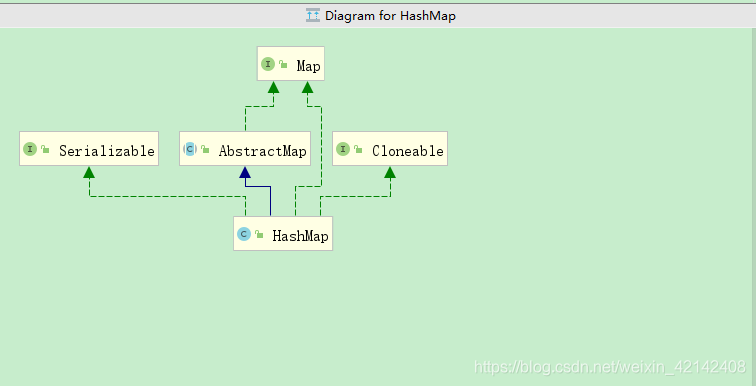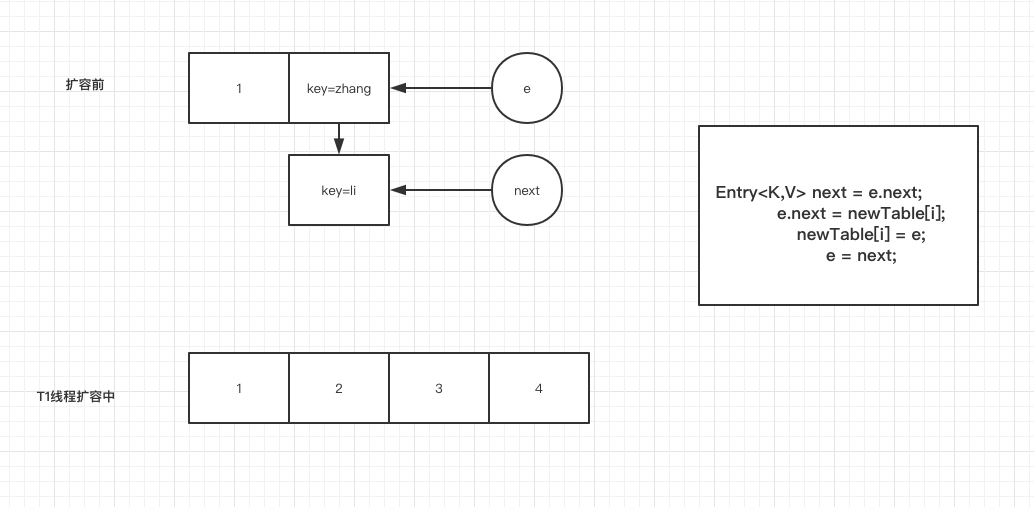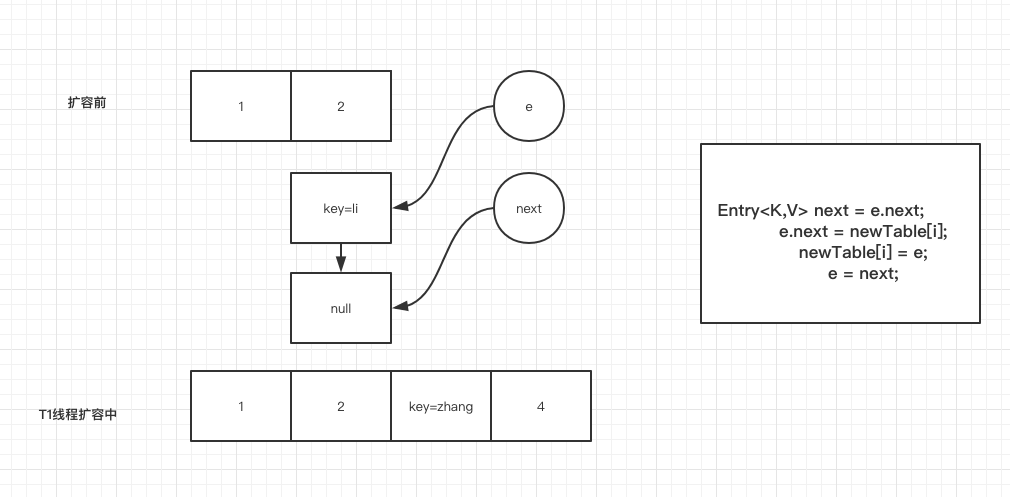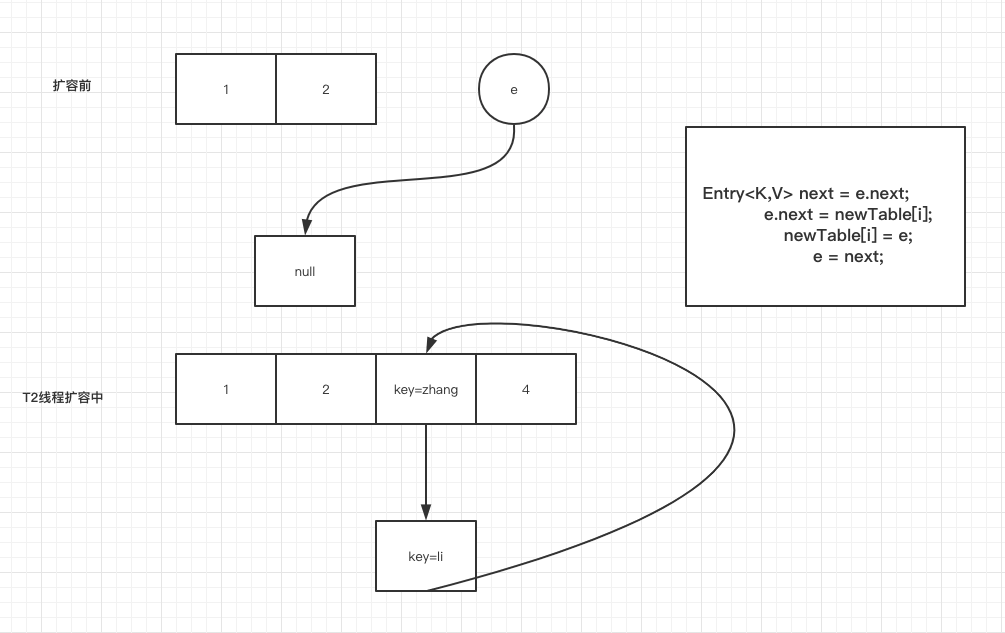Java源码阅读(一)—— HashMap
HashMap 简介
产生的背景
有1w条数据,要对其进行存储,要求做到快速查找或占用较小的空间。
如果内存空间足够大,则可以对每一个key都做一个索引,能够快速查找。
如果查询时间可以足够长,但要节省空间,就可以放到数组中顺序查找。
对二者折中,在时间和空间中寻找一个平衡,由此就有了散列表,在Java中的对应实现就是HashMap。
描述
HashMap是一种散列表的结构,
HashMap 主要用来存放键值对,它基于哈希表的Map接口实现,是常用的Java集合之一。
JDK1.8 之前 HashMap 由 数组+链表 组成的,数组是 HashMap 的主体,链表则是主要为了解决哈希冲突而存在的(“拉链法”解决冲突)。
JDK1.8 以后在解决哈希冲突时有了较大的变化,当链表长度大于阈值(默认为 8)时,将链表转化为红黑树,以减少搜索时间。
HashMap 源码分析
1、继承关系
public abstract class AbstractMap<K,V> implements Map<K,V> {}
public class HashMap<K,V> extends AbstractMap<K,V>
implements Map<K,V>, Cloneable, Serializable {}

2、Map接口
定义了Map的常用方法以及Entry接口
public interface Map<K,V> {
int size();
boolean containsKey(Object key);
V get(Object key);
Set<Map.Entry<K, V>> entrySet();
interface Entry<K,V> {
K getKey();
V getValue();
int hashCode();
}
}
3、AbstractMap抽象类
实现公有方法
public abstract class AbstractMap<K,V> implements Map<K,V> {
protected AbstractMap() {
}
public int size() {
return entrySet().size();
}
public V get(Object key) {
Iterator<Entry<K,V>> i = entrySet().iterator();
if (key==null) {
while (i.hasNext()) {
Entry<K,V> e = i.next();
if (e.getKey()==null)
return e.getValue();
}
} else {
while (i.hasNext()) {
Entry<K,V> e = i.next();
if (key.equals(e.getKey()))
return e.getValue();
}
}
return null;
}
public int hashCode() {
return (key == null ? 0 : key.hashCode()) ^
(value == null ? 0 : value.hashCode());
}
public static class SimpleImmutableEntry<K,V>
implements Entry<K,V>, java.io.Serializable{
......
}
}
4、构造方法
public class HashMap<K,V> extends AbstractMap<K,V>
implements Map<K,V>, Cloneable, Serializable {
//数组初始化大小
static final int DEFAULT_INITIAL_CAPACITY = 1 << 4;
//数组的最大元素数2^30
static final int MAXIMUM_CAPACITY = 1 << 30;
//负载因子,默认为0.75是对时间空间成本进行一个好的折衷
static final float DEFAULT_LOAD_FACTOR = 0.75f;
// 当桶(bucket)上的结点数大于这个值时会转成红黑树
static final int TREEIFY_THRESHOLD = 8;
// 当桶(bucket)上的结点数小于这个值时树转链表
static final int UNTREEIFY_THRESHOLD = 6;
// 桶中结构转化为红黑树对应的table的最小大小
static final int MIN_TREEIFY_CAPACITY = 64;
//构造方法,多用于resize时调用
public HashMap(int initialCapacity, float loadFactor) {
//初始化大小不能小于0
if (initialCapacity < 0)
throw new IllegalArgumentException("Illegal initial capacity: " +
initialCapacity);
//大小大于最大数量,则不再扩容
if (initialCapacity > MAXIMUM_CAPACITY)
initialCapacity = MAXIMUM_CAPACITY;
//负载因子不为负数,NaN是Not a Number的意思,如输入0f / 0f,则返回true
if (loadFactor <= 0 || Float.isNaN(loadFactor))
throw new IllegalArgumentException("Illegal load factor: " +
loadFactor);
this.loadFactor = loadFactor;
//tableSizeFor的作用是保证每次的resize的大小都是2的指数倍
// 输入13,返回的是16
//只有当length = 2的指数时, (length- 1) & a.hashCode() 等价于
// a.hashCode() % (i)));
// 也就是说length为2的指数次幂的意义在于,能够支持与运算,保证结果在0 - (length-1)之间。
this.threshold = tableSizeFor(initialCapacity);
}
public HashMap(int initialCapacity) {
this(initialCapacity, DEFAULT_LOAD_FACTOR);
}
//我们常用的构造方法。
public HashMap() {
this.loadFactor = DEFAULT_LOAD_FACTOR; // all other fields defaulted
}
//使用transient关键字,进行反序列化
transient Node<K,V>[] table;
transient Set<Map.Entry<K,V>> entrySet;
}
5. 负载因子
loadFactor负载因子控制数组存放数据的疏密程度
loadFactor越趋近于1,那么 数组中存放的数据(entry)也就越多,也就越密,也就是会让链表的长度增加。导致查找元素效率低。
loadFactor越小,也就是趋近于0,存放的数据会很分散,导致数组的利用率低,
loadFactor的默认值为0.75f,是官方给出的一个比较好的临界值,是对时间空间成本进行一个好的折中。
threshold
官方解释是The next size value at which to resize (capacity * load factor),可以理解为数组扩容的标准值。threshold = capacity * loadFactor,当Size>=threshold的时候,那么就需要对数组进行扩容。
6、hash方法
先复习下移位操作
2 << 2 //向左移动2位,因为int类型有32位,所以由0...010变为0...1000,值为8
8 >> 2 //向右移动2位,由0...1000变为0...010,值为2
-8 >> 2 //有符号向右移动2位,由1...1000变为1...0010,值为-2
//原码 1000 0000 0000 0000 0000 0000 0000 1000
//补码,对原码取反加1得到 1111 1111 1111 1111 1111 1111 1111 1000
//右移2位,高位补1得到 1111 1111 1111 1111 1111 1111 1111 1110
//针对补码写出的原码为我们要的结果,保留符号位,然后按位取反再加上1
//1000 0000 0000 0000 0000 0000 0000 0010 结果为-2
-8 >>> 2 //有符号向右移动2位,取反码+1,然后右移2位,值为1073741822
//原码 1000 0000 0000 0000 0000 0000 0000 1000
//补码,对原码取反加1得到 1111 1111 1111 1111 1111 1111 1111 1000
//右移2位
//0011 1111 1111 1111 1111 1111 1111 1110 值为1073741822
HashMap的hash方法,hash方法可以防止key实现的hashCode较差,导致的hash冲撞较多的情况。使用了hash方法,可以更好的减少hash冲撞。
以下为JDK1.8的实现方式,相比于JDK1.7的性能要好很多,原因是减少了移位操作的次数。
static final int hash(Object key) {
int h;
return (key == null) ? 0 : (h = key.hashCode()) ^ (h >>> 16);
}
//将key和value进行hashCode计算,然后两个值进行异或操作
public final int hashCode() {
return Objects.hashCode(key) ^ Objects.hashCode(value);
}
JDK1.7的实现方式
static int hash(int h) {
h ^= (h >>> 20) ^ (h >>> 12);
return h ^ (h >>> 7) ^ (h >>> 4);
}
Object的hashCode方法,使用native修饰,说明该方法是由非Java语言实现。
public native int hashCode();
Node
static class Node<K,V> implements Map.Entry<K,V> {
final int hash;
//定义Key为不可变
final K key;
V value;
Node<K,V> next;
Node(int hash, K key, V value, Node<K,V> next) {
this.hash = hash;
this.key = key;
this.value = value;
this.next = next;
}
public final K getKey() { return key; }
public final V getValue() { return value; }
public final String toString() { return key + "=" + value; }
public final int hashCode() {
return Objects.hashCode(key) ^ Objects.hashCode(value);
}
public final V setValue(V newValue) {
V oldValue = value;
value = newValue;
return oldValue;
}
public final boolean equals(Object o) {
if (o == this)
return true;
if (o instanceof Map.Entry) {
Map.Entry<?,?> e = (Map.Entry<?,?>)o;
if (Objects.equals(key, e.getKey()) &&
Objects.equals(value, e.getValue()))
return true;
}
return false;
}
}
static final class TreeNode<K,V> extends LinkedHashMap.Entry<K,V> {
TreeNode<K,V> parent; // red-black tree links
TreeNode<K,V> left;
TreeNode<K,V> right;
TreeNode<K,V> prev; // needed to unlink next upon deletion
boolean red;
TreeNode(int hash, K key, V val, Node<K,V> next) {
super(hash, key, val, next);
}
//返回根节点
final TreeNode<K,V> root() {
for (TreeNode<K,V> r = this, p;;) {
if ((p = r.parent) == null)
return r;
r = p;
}
}
}
6、插入值方法
HashMap的putVal方法
public V put(K key, V value) {
return putVal(hash(key), key, value, false, true);
}
final V putVal(int hash, K key, V value, boolean onlyIfAbsent,
boolean evict) {
Node<K,V>[] tab; Node<K,V> p; int n, i;
if ((tab = table) == null || (n = tab.length) == 0)
n = (tab = resize()).length;
if ((p = tab[i = (n - 1) & hash]) == null)
tab[i] = newNode(hash, key, value, null);
else {
Node<K,V> e; K k;
if (p.hash == hash &&
((k = p.key) == key || (key != null && key.equals(k))))
e = p;
else if (p instanceof TreeNode)
e = ((TreeNode<K,V>)p).putTreeVal(this, tab, hash, key, value);
else {
for (int binCount = 0; ; ++binCount) {
if ((e = p.next) == null) {
p.next = newNode(hash, key, value, null);
if (binCount >= TREEIFY_THRESHOLD - 1) // -1 for 1st
treeifyBin(tab, hash);
break;
}
if (e.hash == hash &&
((k = e.key) == key || (key != null && key.equals(k))))
break;
p = e;
}
}
if (e != null) { // existing mapping for key
V oldValue = e.value;
if (!onlyIfAbsent || oldValue == null)
e.value = value;
afterNodeAccess(e);
return oldValue;
}
}
++modCount;
if (++size > threshold)
resize();
afterNodeInsertion(evict);
return null;
}
8、get方法
public V get(Object key) {
Node<K,V> e;
return (e = getNode(hash(key), key)) == null ? null : e.value;
}
final Node<K,V> getNode(int hash, Object key) {
Node<K,V>[] tab; Node<K,V> first, e; int n; K k;
if ((tab = table) != null && (n = tab.length) > 0 &&
(first = tab[(n - 1) & hash]) != null) {
if (first.hash == hash && // always check first node
((k = first.key) == key || (key != null && key.equals(k))))
return first;
if ((e = first.next) != null) {
if (first instanceof TreeNode)
return ((TreeNode<K,V>)first).getTreeNode(hash, key);
do {
if (e.hash == hash &&
((k = e.key) == key || (key != null && key.equals(k))))
return e;
} while ((e = e.next) != null);
}
}
return null;
}
多线程下的resize()
final Node<K,V>[] resize() {
Node<K,V>[] oldTab = table;
// 假设oldCap = 16
int oldCap = (oldTab == null) ? 0 : oldTab.length;
// 那么oldThr = 16 * 2 = 32,threshold为下一次resize时的大小
int oldThr = threshold;
// newCap 新的数组容量大小
int newCap, newThr = 0;
if (oldCap > 0) {
if (oldCap >= MAXIMUM_CAPACITY) {
threshold = Integer.MAX_VALUE;
return oldTab;
}
// newCap = 16 * 2 = 32
else if ((newCap = oldCap << 1) < MAXIMUM_CAPACITY &&
oldCap >= DEFAULT_INITIAL_CAPACITY)
// newThr,下一次resize大小变为32 * 2 = 64
newThr = oldThr << 1; // double threshold
}
else if (oldThr > 0) // initial capacity was placed in threshold
newCap = oldThr;
else { // zero initial threshold signifies using defaults
newCap = DEFAULT_INITIAL_CAPACITY;
newThr = (int)(DEFAULT_LOAD_FACTOR * DEFAULT_INITIAL_CAPACITY);
}
if (newThr == 0) {
float ft = (float)newCap * loadFactor;
newThr = (newCap < MAXIMUM_CAPACITY && ft < (float)MAXIMUM_CAPACITY ?
(int)ft : Integer.MAX_VALUE);
}
threshold = newThr;
// 到这里创建了一个大小为原来2倍,即32的数组。
@SuppressWarnings({"rawtypes","unchecked"})
Node<K,V>[] newTab = (Node<K,V>[])new Node[newCap];
table = newTab;
if (oldTab != null) {
for (int j = 0; j < oldCap; ++j) {
Node<K,V> e;
if ((e = oldTab[j]) != null) {
oldTab[j] = null;
if (e.next == null)
newTab[e.hash & (newCap - 1)] = e;
else if (e instanceof TreeNode)
((TreeNode<K,V>)e).split(this, newTab, j, oldCap);
else { // preserve order
Node<K,V> loHead = null, loTail = null;
Node<K,V> hiHead = null, hiTail = null;
Node<K,V> next;
do {
next = e.next;
if ((e.hash & oldCap) == 0) {
if (loTail == null)
loHead = e;
else
loTail.next = e;
loTail = e;
}
else {
if (hiTail == null)
hiHead = e;
else
hiTail.next = e;
hiTail = e;
}
} while ((e = next) != null);
if (loTail != null) {
loTail.next = null;
newTab[j] = loHead;
}
if (hiTail != null) {
hiTail.next = null;
newTab[j + oldCap] = hiHead;
}
}
}
}
}
return newTab;
}
transfer扩容形成单链表环操作演示
void transfer(Entry[] newTable, boolean rehash) {
int newCapacity = newTable.length;
for (Entry<K,V> e : table) {
while(null != e) {
Entry<K,V> next = e.next;
if (rehash) {
e.hash = null == e.key ? 0 : hash(e.key);
}
int i = indexFor(e.hash, newCapacity);
e.next = newTable[i];
newTable[i] = e;
e = next;
}
}
}
有T1、T2两个线程,分别都执行到获取e指针这步,假设T1执行,T2阻塞。

完成第一个循环时

完成第二个循环时

这时T1停顿,T2开始进行扩容操作,T2的e指针指向的是最初的元素也就是key=zhang的元素。

开始执行循环中的代码e.next = newTable[i];后

执行代码newTable[i] = e;后,形成环

最后执行e = next;收尾

附部分相关方法
public static boolean isNaN(float v) {
return (v != v);
}
static final int tableSizeFor(int cap) {
int n = cap - 1;
n |= n >>> 1;
n |= n >>> 2;
n |= n >>> 4;
n |= n >>> 8;
n |= n >>> 16;
return (n < 0) ? 1 : (n >= MAXIMUM_CAPACITY) ? MAXIMUM_CAPACITY : n + 1;
}
关于作者
后端程序员,五年开发经验,从事互联网金融方向。技术公众号「清泉白石」。如果您在阅读文章时有什么疑问或者发现文章的错误,欢迎在公众号里给我留言。



